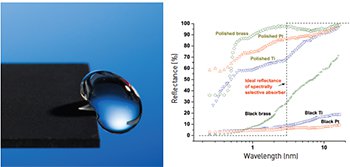 (Left) The black superhydrophobic titanium surface repelling a water droplet. (Right) Spectral reflectance of untreated (polished) and treated (black) titanium, platinum and brass. [A.Y. Vorobyev and C. Guo. J. Appl. Phys. 117, 033103 (2015)]
(Left) The black superhydrophobic titanium surface repelling a water droplet. (Right) Spectral reflectance of untreated (polished) and treated (black) titanium, platinum and brass. [A.Y. Vorobyev and C. Guo. J. Appl. Phys. 117, 033103 (2015)]
Nature provides many examples of surfaces that exhibit multifunctional properties. Morpho butterfly wings, for instance, have structures that produce a blue color and make the wing surface superhydrophobic and self-cleaning. Inspired by these biological surfaces, we created multifunctional surfaces on metals with hierarchical surface nano/microstructures using direct femtosecond laser ablation.1 Our multifunctional surfaces exhibit excellent broadband light absorption, superhydrophobicity and self-cleaning functionalities.
We used an amplified Ti:sapphire femtosecond laser system to produce hierarchical surface nano/microstructures on platinum, titanium and brass. Each surface is textured with an array of parallel microgrooves covered with nanostructures. For our demonstrations, the water-drop contact angle was 158 degrees and the drop slid on the treated surface at a tilt angle of four degrees. When we released drops of water onto the treated surface, the drops were repelled by the treated surface to such a degree that they bounced off the surface.2
In nature, self-cleaning occurs on a superhydrophobic surface with water from rain, dew and fog. Self-cleaning is achieved when water drops roll over the surface, picking up the dust particles, and carrying them away as they roll off the surface. (In the supplementary video, we demonstrate black platinum’s self-cleaning ability by applying a string of water drops.)
We measured the reflectance of mechanically polished platinum, titanium and brass surfaces before and after laser treatment. After laser treatment, the multifunctional surfaces had a very low reflectance over a broad range of wavelengths. The reflectance in the visible wavelengths is in a range of 1.3 to 3.5 percent, 3.3 to 4.1 percent, and 4.2 to 4.5 percent for brass, platinum, and titanium, respectively. Because of the extremely low reflectance, all three laser-treated surfaces appear black. The hierarchical surface structures produced on platinum and titanium are more optimized for the broadband absorption in the wavelength range of 0.25 to 16 μm, while structures on brass are more optimized for solar energy absorption, where the ideal wavelengthdependent reflectance R(λ) should be R(λ) = 0 at 0.3 < λ < 3 μm, and R(λ) = 1 at 3 < λ < 50 μm.
The enhanced absorption properties of the three laser-treated surfaces will be useful for light-collection applications, such as sensors and solar cells. The self-cleaning property will improve device performance and minimize maintenance. The superhydrophobicity property will enable other desirable functionalities, such as anti-corrosion, anti-icing, antibiofouling and self-sanitation.
Researchers
Anatoliy Y. Vorobyev and Chunlei Guo, Institute of Optics, University of Rochester, N.Y., USA
References
1. A.Y. Vorobyev and C. Guo. J. Appl. Phys. 117, 033103 (2015).
2. University of Rochester. www.youtube.com/watch?v=FLegmQ8_dHg (2015).
